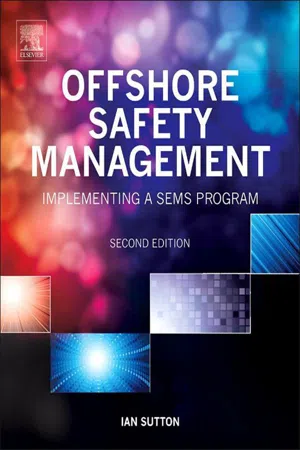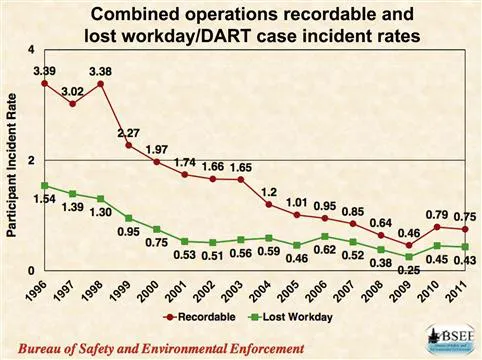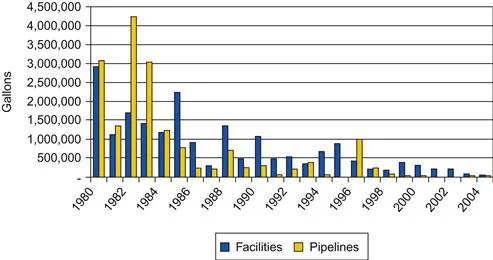![]()
Chapter 1
Risk Management
This chapter describes the principles of risk management as they apply to the offshore oil and gas industry, the impact the Deepwater Horizon/Macondo event had on the industry and how safety management systems have evolved in response. The fundamentals of safety management are described including: acceptable risk, process safety and culture, the use of risk matrices, the economics of offshore safety, means of measuring progress, and leading and lagging indicators. The distinction between prescriptive and nonprescriptive systems is discussed.
Keywords
Safety management systems; Deepwater Horizon; Macondo; risk management; acceptable risk; ALARP; leading and lagging indicators; economics of safety
Chapter Contents
Introduction
Impact of Deepwater Horizon/Macondo
Process safety trends
Offshore
The pipeline industry
Safety management systems
Organization of this book
Historical background
Onshore developments
Occupational safety, process safety, and culture
Occupational safety
Process safety
The Baker Report
The incident triangle
Risk management
Perception of the consequence term
Performance-based/prescriptive programs
Nonprescriptive
Performance-based
Fiberglass composite pipe example
Acceptable risk
Uncertainty
Cost-benefit analysis
Risk reduction
As low as reasonably practicable risk—ALARP
Setting ALARP
Difficulties with ALARP
Reverse ALARP
Risk matrices
Consequence matrix
Frequency matrix
Risk matrix
Safety management systems
Fundamentals
Safe limits
Holistic
Involvement and thoroughness
Operators
Elements of an SMS
1. Facility description
2. Technical information
3. Risk assessment
4. Risk acceptance
5. Report
6. Audit
Economics
Benefits
Costs
BOEMRE data
Measuring progress
Lagging and leading indicators
Lagging indicators
Leading indicators
Key performance indicators
Tier 1—Process safety event
Tier 2—Process safety event
Tier 3—Challenge to safety systems
Tier 4—Operating discipline and management system performance
Safety as a causal factor
Culture
References
Introduction
The offshore oil and gas business is hazardous. Some of the many issues to be concerned about include the following:
• Explosions and fires.
• Weather conditions can be harsh and unforgiving.
• Toxic gases, particularly hydrogen sulfide (H2S), are a frequent by-product of the oil and gas that is produced.
• Emergency response can be a challenge; platforms and rigs are small and congested. And the people on board have to respond with the resources they have; outside help is not usually quickly available.
Thus, from its very beginning this industry has had to pay particular attention to the safety of the workers and the prevention of catastrophic events. Generally these efforts have been successful, particularly with regard to occupational or personal safety, as illustrated in Figure 1.1, which shows the progress that has been made in recent years in the United States (mostly the Gulf of Mexico).
Figure 1.1 Safety trends—United States Outer Continental Shelf. (Source: United States Mineral Management Service, 2009)
Figure 1.1 was first published by the United States Mineral Management Service (MMS)—the government agency responsible, at the time, for offshore safety regulation and enforcement. These responsibilities for the MMS are now handled by the Bureau of Safety and Environmental Enforcement—BSEE. The chart provides data to do with the number of offshore safety incidents for the period 1996 to 2011. The trend is impressive: in just 12 years the recordable injury rate declined from 3.39 to 0.75, a drop of around 80 percent. And the number of lost workdays dropped by a similar percentage. Moreover the trend is quite smooth and steady, showing that the results are not a fluke or one-time event. And these advances were made as the industry has worked in ever-more challenging conditions—particularly as it has moved into very deep water operations.
Figure 1.2 shows a similar positive trend with respect to the industry’s environmental record. The data, which are provided by the United States Coast Guard, include some land-based facilities, and also spills from inshore (state) waters. If the two bars for each of the years in Figure 1.2 are combined, it can be seen that the amount of oil spilled annually has declined from just under 6 million gallons in the early 1980s to an almost negligible amount by the year 2005.
Figure 1.2 Environmental trends—Offshore United States.
Impact of Deepwater Horizon/Macondo
The trends shown in Figures 1.1 and 1.2 are largely attributable to improvement in occupational or personal safety. And prior to the year 2010, the trends to do with major events such as fires and blowouts also seemed to be favorable, although the level of improvement was not as great for personal safety and the quality of the data was not nearly as good.
Then came the Deepwater Horizon explosion and fire followed by the spill of oil from the Macondo well.
To say that this catastrophe was a shock to the industry would be a gross understatement. Not only was the initial impact of the loss of life, the destruction of the rig, and the massive spill dramatic enough, but the event showed that systems were not in place to respond promptly to a catastrophe of this magnitude. In particular, it took 5 months before the well could be sealed; and during those 5 months, dramatic scenes were broadcast around the world showing oil pouring into the ocean 1 mile down. Equally compelling footage of events onshore, such as the death of wild birds and the closure of many small businesses, added to the impression of a situation out of control. In other words, the Deepwater Horizon event had public relations implications that went way beyond the losses associated with just one drilling rig. As the National Commission Report (2011) described on page 75 to President Obama said:
Deepwater energy exploration and production, particularly at the frontiers of experience, involve risks for which neither industry nor government has been adequately prepared, but for which they can and must be prepared in the future.
Moreover, the event revealed structural flaws in the safety management systems of offshore facilities.
The discussion concerning Titanic disaster in Chapter 2 provides the following quotation (Brander 1995):
The Titanic disaster suddenly ripped away the blindfolds and changed dozens of attitudes, practices, and standards almost literally overnight.
The same comment could be applied to the Deepwater Horizon catastrophe.
At the time of writing, the consequences raised by Deepwater Horizon are not confined to the offshore oil and gas industry. At the time of this writing, the consequences of the severe damage to the Fukushima nuclear power plants in Japan are still being ascertained. But it is clear that those consequences will be profound; substantial quantities of radioactive materials have been released, a significant fraction of Japan’s power-generating capability is lost forever, and the cost of clean-up and remediation is going to be enormous. Indeed, the Fukushima accident may result in a massive slowdown in the construction of new nuclear power plants worldwide. Clearly, the offshore oil and gas industry is not the only one facing major challenges with respect to the management of safety and environmental performance.
Process safety trends
Figure 1.1 shows the impressive improvements that have occurred in occupational safety over the last two decades. It is difficult to develop com...


